RETAIL FURNITURE HERITAGE 1800-2010
These Are Your Stories -Part 2
by Janet Holt-Johnstone
Many of our most enterprising home furnishings retailers have shared their stories of survival, growth and service with FURNITURE WORLD readers. This is the second installment in a series that commemorates the 140th anniversary year of FURNITURE WORLD Magazine.
These are your stories, the tales you told us, the dreams that became realities.
Mel Loory had the last word(s) in Part One of this series when he said, “Perhaps that’s the secret of our success... harmony between the past and the present and optimism about the future.” Now he sets the stage to re-enter our FURNITURE WORLD time machine. (Part One is archived with the entire March/April 2010 anniversary issue on www.furninfo.com.)
MOUNT MORRIS - 1913
It was back in 1913 that Sam and Mary Bozzette opened their store in Mount Morris in the Genesee Valley, just five minutes away from Letchworth State Park. They promised the town’s folk they would “revolutionize furniture values with savings so great that we are sure it will only take a minute to make up your mind”. But once customers crossed the threshold, they found it difficult to leave. In the early days, the family’s living room and kitchen were located on the first floor, right behind the showroom, their bedrooms above the store. The enticing and pervasive fragrance of Mary’s good Italian cooking greeted everyone and held them captive. And undoubtedly influenced their purchases!
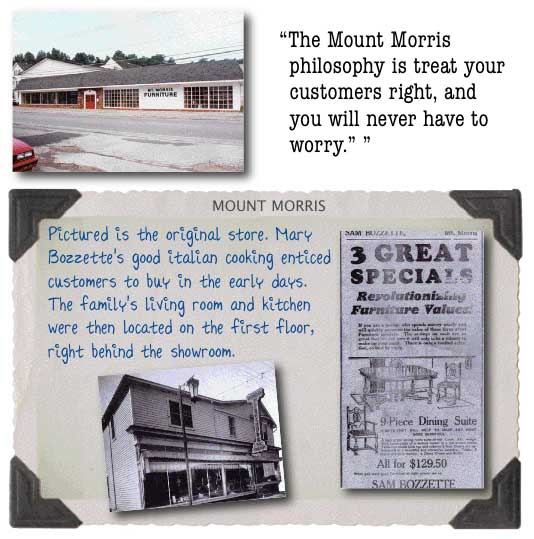
“As the store’s reputation grew, so did their business,” said Sam and Mary’s son, Louis. Lou’s history at Mount Morris Furniture began in his early teens, assembling furniture after school. “Nearly every year, even during the great depression, a few more square feet were added to the store.”
Lou graduated from New York Military Academy, a boarding school north of New York City, just in time to serve the last two years of World War II states-side in the U.S. Air Force as a B29 bomber radio repairman. After discharge, he officially joined the family business as store manager.
He believed strongly in the power of marketing, and initiated advertising campaigns in newspapers, on radio and, eventually, television. Lou bought the business from his parents in 1956 with the commitment to maintain their uncomplicated philosophy. “Treat your customers right, and you will never have to worry.” He also continued their growth pattern, enlarging the showroom and building a 10,000 square foot state-of-the-art high rise warehouse.
And he believed in “giving back to the community that gave him so much”. He was a member of the Mount Morris Merchants Association, Charter Member of the Livingston County Chamber of Commerce, served on the Boards of Directors of Mount Morris Historical Society and Noyes Memorial Hospital, and is a third degree member of the Knights of Columbus.
In 1982, the 390 expressway made travel to Metropolitan Rochester an easy drive to and from the Genesee Valley. This was an opportunity to expand the store’s customer base to the lucrative Rochester market. Lou had already extended media reach in the ‘60s.
His vision included recognition of the aesthetic in store design and product display. Lou was one of the first to develop room vignettes, and he was keenly aware of fashion trends, offering fresh contemporary looks as well as tried and true traditional styling.
Main Street Mount Morris was once the shopping hub of the Valley, and Lou, now retired, strongly believes specialty businesses can thrive in a small community. The “restoration and revival of Main Street” will happen.
Third generation Jim Stallone, Lou’s son-in-law, heads up the operation these days, and fourth generation Kristin Stallone DiProsa became Director of Marketing and Advertising 10 years ago. The spirit of optimism continues at Mount Morris!
ROBB & STUCKY - 1915
Two years after Sam and Mary began to build their dream in Mount Morris, Robb & Stucky put down roots in Fort Myers, Florida, then as a one-store general merchandise emporium.
“Because Robb & Stucky has been in business since 1915, there is trust in the name that has been around for almost 95 years. A company that has survived a depression, wars and recessions and is still thriving, shows the ability to stay the course at every turn,” said corporate spokesperson, Janet Wilson.
Over the years, the company evolved into a nationally recognized, award-winning interior design and premier home furnishings retailer offering a unique lifestyle shopping experience. Clients have included luminaries Henry Ford, Thomas Edison and Harvey Firestone.
In 1979, Robb & Stucky was purchased by the Mariner Group and Clive Lubner, currently the company’s chief executive officer. In the ensuing 31 years, the company has expanded from two Florida showrooms to 30 facilities in Florida, Texas, Arizona, North Carolina and Nevada and continues to grow, employing more than 1,300 employees.
“The company has never wavered on its brand promise and will always deliver exceptional service, great value and unparalleled design talent. There is pride in what the company does. It does not have to reinvent itself, the company knows who it is and that is a strength.”
Spend some time with Robb & Stucky on their excellent website, www.robbstucky.com. It’s a dazzling experience!
EL DORADO FURNITURE
There’s more to this optimism theme. The beginnings of El Dorado Furniture date back to the island of Cuba in the 1920s. Simon Capo originally traded farm products for used furniture that he restored and would later sell. He eventually grew this small business into a chain of five furniture stores he named Casa Capo and, by 1950, Casa Capo was one of Cuba’s largest furniture manufacturing and retail enterprises.
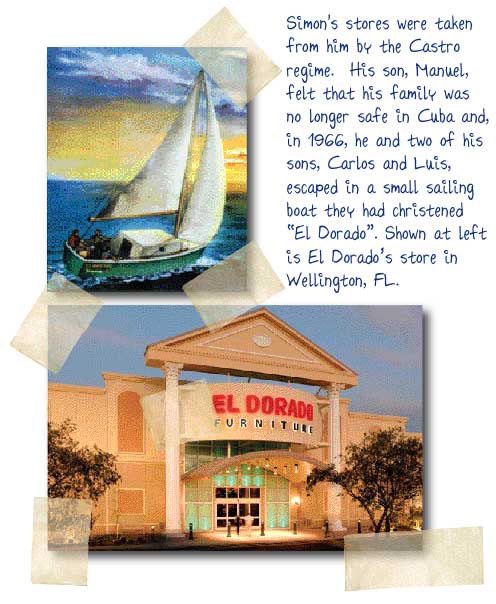
But once Fidel Castro came to power, Simon’s stores were taken from him. His son, Manuel, felt that his family was no longer safe in Cuba and, in 1966, he and two of his sons, Carlos and Luis, escaped from Cuba in a small sailing boat they had christened “El Dorado”. They disembarked in Mexico, and made their way to the U.S., receiving political refugee status.
The family returned to what they knew best, furniture, and opened their first store in Miami’s Little Havana, named El Dorado after the boat that had freed them from Cuba.
Said Luis, “As I look back, I can vividly remember the beginning when my father, my brother and myself struggled to survive in a new country. The only assets we possessed were the joy of being free, the longing for the family left in Cuba and a burning desire to succeed. We found strength in each other and in this great nation that welcomed and believed in us, opening the doors of opportunities denied to us in our own country.
“Today I am proud to say each and every one of our employees works with our same enthusiasm and dedication, making El Dorado Furniture a successful and prestigious organization. Our philosophy is consistent: to continue to grow and lead in the furniture industry while preserving the personal touch.”
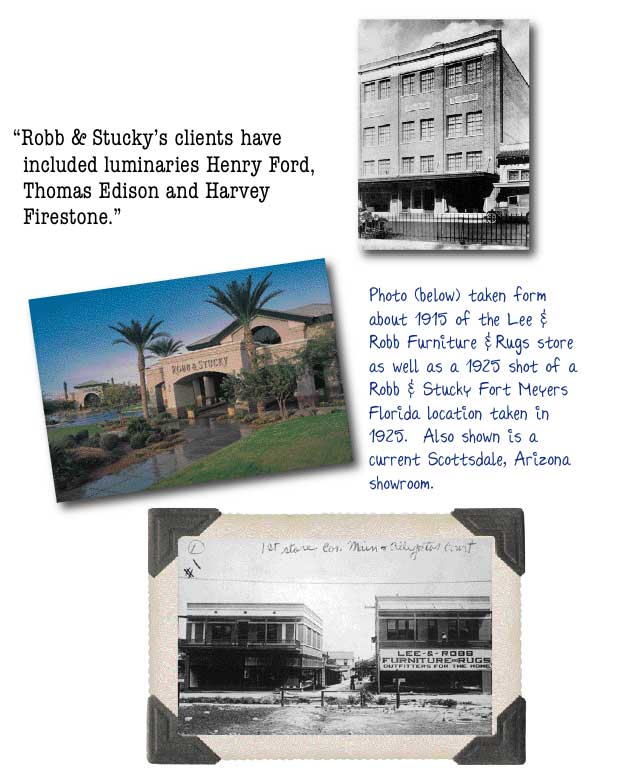
El Dorado ranks within the top 50 out of more than 35,000 furniture stores in the U.S. today. Their corporate goal is no less than to be the top furniture retailer in the country. “We will continue to grow as we have done by providing outstanding customer service, reaching new levels of performance and always remembering the sky is the limit!” El Dorado Furniture is wholly owned and operated by the Capo family. Father Manuel and his seven sons all hold executive positions within the corporation.
Creative innovation is another El Dorado landmark. Imagine a series of showrooms centered on a “main street” called the Boulevard, designed with realistic building facades, old fashioned street lamps and benches that give you the feeling of being in a heritage town. The Boulevard opens into individual specialized furniture stores or galleries, in total 110,000 square feet of showroom space. Musical entertainment is offered during weekends. At select stores, children are offered videogames and movies. Adults can take a break at El Dorado’s Woodmups Café. A rare home furnishings experience! And optimism in action.
TEPPERMAN’S
Optimism obviously crosses borders, many borders. The sun was shining in Windsor, Ontario, a long way north of Little Havana and just across the river from Detroit, when Nate Tepperman initiated his own dynasty. The young, Russian born entrepreneur kicked off the Tepperman vision when he made his epic first sale of towels, sheets and rugs door-to-door. Four years later, he opened “his first little store on Ottawa Street”, and one year after that made the most inspired decision of his life when he doubled the size of his staff “by hiring a good bookkeeper, Rose Eisen. Soon after, he marries her to cement the relationship, and they later have two children (Bill and Harriet) to make the relationship even more permanent”.
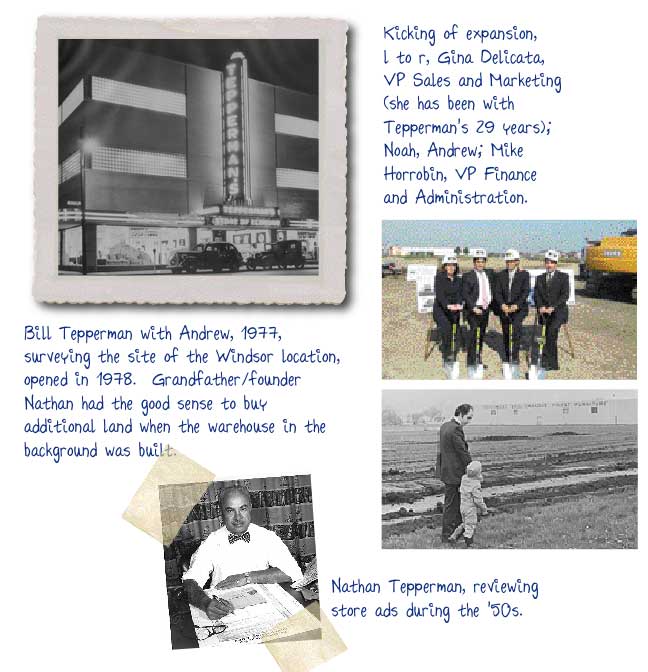
The storytellers are Nate’s grandsons, Andrew and Noah. They’ve burned happy midnight hours journalizing the Tepperman Tale and their enlightening and entertaining commentary will be interspersed throughout this portion of our saga. They continue, “1940. Nate builds a new 18,000 square foot store with displays on both the basement level and main floor.” Seven years later, he doubled the display area with the major construction of the second and third floors. And this made Tepperman’s the largest, most modern store of its kind in Windsor, a landmark for 31 years.
1948, a shining year, when Bill, age 12, made his first sale. Four years later the City of Windsor, in its drive to open up the city’s waterfront, expropriated Tepperman’s main warehouse, but within two years the family had replaced it with a 450,000 square foot warehouse at Ouellette Place, “a preparation for increased volume”.
Young Bill came of age when he married Rochelle Laurie, a multi-talented multi-tasker like himself. She raised three sons while simultaneously participating in a host of volunteer activities. In time she became an elected member of the Windsor School Board, the Chair of the Windsor Police Services Board, the Chair of the Ontario Association of Police Services Boards and a Vice President at Tepperman’s!
1970 was a sad year when founder and grandfather Nathan drowned while on vacation. Bill, along with Rochelle’s brother, Harry Eisen, assumed leadership, but in only two years Harry retired due to ill health, leaving Bill in charge.
In 1973 the warehouse was expanded again to 650,00 square feet, and in 1975 Tepperman’s celebrated its 50th year in business. In 1976 the warehouse hit the million mark.
Andrew made the scene at age seven in 1977, his first job, manually sorting Accounts Receivable cards for 25 cents an hour, his strict supervisor Rose Tepperman, his grandmother.
The pace quickened. 1978, another new store opened, Southwestern Ontario’s largest and most modern; 1981, a new store in downtown Chatham; at the same time, another 500,000 square foot warehouse expansion.
And Noah, age 8, “takes his first turn at Tepperman’s employment”, also “sorting Accounts Receivable cards, also under strict supervision”.
1984, marked the arrival of the first ever Bargain Annex store in Windsor, a “clearing house for scratch-n-dent, repossessed, as-is and one-of-a-kind merchandise. It quickly became, in addition, a retail outlet that carried its own lines of in-stock goods, focusing on value oriented, entry level price point customers”.
In 1986, the ever-growing warehouse grew again, to more than two million square feet. Computerization of sales, inventory and accounts receivable systems arrived on Tepperman’s 65th birthday in 1990 and, the following year, once again leading the way, the Ultimate 2000 Guarantee was made reality with P.D.Q. next day deliveries, a 90 day Price Guarantee, discounts and free rides to and from Tepperman stores in Windsor and Chatham for senior citizens. And there was a relocation of the Chatham store.
1992 was both exciting and frightening. The Chatham store burned to the ground and Bill and his staff broke all records by opening a temporary fire disaster store within six weeks. But expansion was continuing in Windsor, the Bargain Annex, and marketing efforts now included the offer of a new car if competitor’s prices could not be beaten, the first company in North America to offer such an incentive.
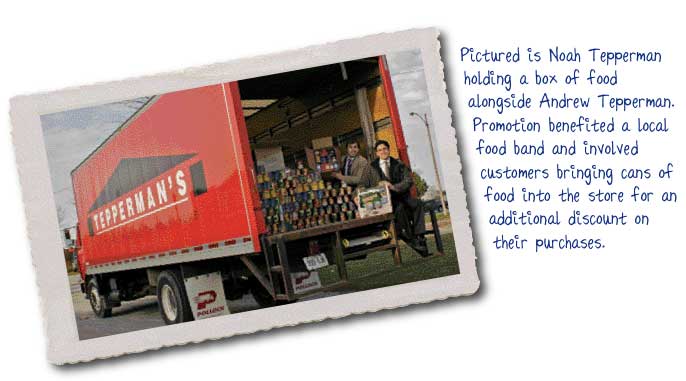
The 1993 recession marked the opening of a new store in the town of Sarnia, and in three years time software and hardware and radio frequency controls were expanded.Yet another expansion, this time to London, Ontario in 1997, and Andrew officially joined the dynasty’s flow when he was chosen to lead London operations, 62,000 square feet with 89,000 square feet of warehouse space. And, at that point in time, Tepperman’s became the largest independent furniture retailer in Canada.
On another level, 1998 was a monumental year when the team kicked off the Canadian Scholarship Trust programme. The brothers explain, “Four children under the age of 10 win a post-secondary scholarship trust each month. Through year 2009 Tepperman’s has invested over $520,000 in this programme”.
The 75th anniversary coincided with the millennium. Andrew relocated to Windsor and became Buyer for the Bargain Annex, and his brother Noah joined the firm as the creator and first director of the new human resources department. Staff grew to more than 280.
The following year, a new 35,000 square foot store was constructed in Sarnia, and the Windsor store received a major renovation. Two years later construction was completed on a new retail location in Chatham, doubling the existing square footage and introducing a Bargain Annex to Chatham. And Bill was honoured by the Ontario Furniture Manufacturers’ Association as their Retailer of the Year, only the second time this award had been presented.
The following year, “we implemented a new credit decisioning software package, reducing the amount of time customers wait for decision on their credit application and providing sensational customer service to an increased number of customers everyday”.
Yet another anniversary year, the 80th, was celebrated in 2005, especially important since “Noah became the ‘voice of Tepperman’s’, recording all on-air advertising. Family to Family . . . . That’s The Difference.
“One of the most important recent changes dates back to 2006, when our father retired after 36 years as President. He methodically prepared a well structured transition plan that began five years prior. The plan was so successful that he was able to retire on the exact day he set out five years before. We have a very strong leadership team that enabled us to successfully transition. This plan ensured we were prepared to continue to build on our history, to expand our reach and satisfy more customers.”
Andrew became company president, Noah Secretary and Treasurer as well as Director of Customer Care; Bill is Chairman of the Board and Rochelle, Vice-Chair. (And she was also awarded “Volunteer of the Year” award by Leadership Windsor/Essex.)
This year the family’s new London store (it sits on approximately 15 acres), won a regional design construction award, “Don Smith Commercial Building of the Year”. It’s a new programme that recognizes environment sensitivity, design and innovation and the extent to which the new local buildings meet a specific developmental need within the community. . Single level, with 85,000 square feet of office and selling space and a 100,000 square foot distribution centre with 42 feet of clearance, the store offers “almost twice as many products with the same footprint, and total storage volume amounts to about four million square feet.”
We asked if Andrew could cite “a eureka moment” in Tepperman’s history. “We can go back to when our founder, Nate, decided to buy a car in the 1920s to sell his products door to door instead of on his bicycle. Or each time a family member made a major investment to grow during an economic downturn. A continuous improvement philosophy. Empowering people to experiment. Very aggressive marketing. Knowing that recessions are times to pick up market share, not crawl under a rock. The tenure of our leadership team, from our VPs Mike Horrobin, 18 years, and Gina Delicata, 28 years.”
All contributing factors, without doubt.
Andrew is now a member of the Executive Board of the NHFA, and belongs to a specialized international Performance Group. Outstanding, universal elements amongst this landmark group of home furnishings retailers? Hard work. Perseverance. Belief. And, most certainly, optimism!
Which leads us from the roaring twenties inexorably into the drama of the 1930s. Part Three, many more stories to come!
SEPTEMBER/ OCTOBER ISSUE: THE STORIES CONTINUE!
The celebration of your longevity and ours will continue in Furniture World’s next issue, advancing toward our present times with retail histories completed so far, and others out there who were perhaps just not able to find that right vintage photo in time. Keep looking, it’s not too late. Just email editor@furninfo.com for details.
The industry and all of us at Furniture World will thank you!
Janet Holt-Johnstone is an international marketer and editor, happily contributing to Furniture World Magazine for the past 20 years. She also writes/edits for CanWest publications, the Globe and Mail, The Toronto Star and many shelter magazines, and edited the award-winning Korean War epic, “One Bugle, No Drums”, by William B. Hopkins. Janet has just completed her first novel, “The Devil Knows”.